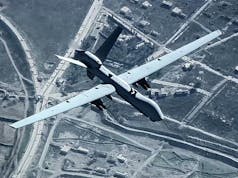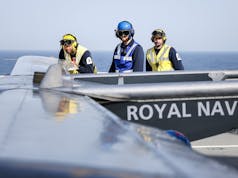BAE Systems received a $4 million contract from the U.S. Navy to conduct a quick-turnaround demonstration of a new radio frequency countermeasure (RFCM) system for the P-8A Poseidon.
The pod-mounted RFCM system is a “leading-edge, lightweight, high-power system” that will add a new self-protection capability to this next-generation U.S. Navy aircraft.
“The ability to meet this unprecedented response time underscores our agility, focus on meeting customer needs, and our ultimate goal of protecting our warfighters,” said Don Davidson, director of the Advanced Compact Electronic Warfare Solutions product line at BAE Systems.
“A process that used to take 18 to 24 months has been scaled to five or six months, which is remarkable, as is deploying this new self-protection capability.”
The firm say that the rapid response is the result of collaboration among small focus teams who developed an innovative approach to the design and fabrication of the system’s mechanical parts. As a result, BAE Systems will design, build, integrate, and ship the RFCM system in approximately five months, followed by two months of flight testing on the P-8A Poseidon platform. Testing will begin early in 2021.
The RFCM system consists of a small form factor jammer, a high-powered amplifier and the AN/ALE-55 Fiber-Optic Towed Decoy (FOTD).














I’d expect Britecloud to be fitted to our Wedgetails and Poseidons. This will provide the same level of protection perhaps even better. As they are fired away from the aircraft, so if the missile has a home on to jammer mode, the aircraft is still protected.
Americans love to sell in bulk, sell cheap contracts which always balloon up, and it turns out, they always have inferior kit to Europeans. I think we should go with Leonardo as you mention.
Have you seen the specs for this system? I’ll bet not. Yet somehow you know that it is inferior to Britecloud just because it’s American. How do you know that it won’t be fitted on the UK or Aussie or Norwegian or Japanese P-8s? Maybe it’s better and cheaper. I don’t know and you sure don’t.
At what point did I say the system is inferior to Britecloud just because it is American?
The other thing to note from the image above, is that the decoy system uses up a hard point.
The AN/ALE-55 Fibre Optic Towed Decoy (FOTD) has been around for the last ten years and is currently used on US F18s. Much like the Typhoon’s Preatorian DASS active towed decoy, it operates in the X to Ku bands (H to J) as published by BAe. These bands represent not only the majority of missile tracking radars but also some active RF missile seekers.
However, a towed active decoy is supposed to be sacrificial, it has but one job to protect the aircraft. It does this by spoofing the opponents radar with a larger false signal. There are really two techniques for this one is to have the towed decoy as a passive multi-reflector that generates a larger radar cross section than the targeted aircraft. The passive method is not used anymore as it presented the radar with two targets instead of hiding the threatened aircraft. The other method is to have an active radar repeater. This basically captures the signal, amplifies it and retransmits it. The signal is vaguely manipulated and generates false range information to the tracking radar. However, this system is only really good at spoofing traditional pulse doppler radars. It struggles to spoof PESA and especially AESA radars. The newest method is to capture the opponents radar signal, carry out a phase change and then retransmit it as an amplified signal, which should mask the targeted aircraft. Before as late as 2010 this was a very complex process, but then digital radio frequency memory (DRFM) came along. DRFM is used to capture the whole waveform of the transmitted radar signal. It can then manipulate it, by phase changing it, inverting it as per Rafale’s Spectra, or just delaying the reply. It can also generate a string of ghost images by repeating waveforms at selected or random intervals.
The problem the towed system has is, if it is hit and destroyed, the aircraft is left unprotected. Typhoon carries a pair of decoys whilst the F18 usually only has one. This is why Typhoon also now incorporates Britecloud.
Britecloud is also an expendable decoy, it has been designed to replace chaff. Chaff (Window) are fibreglass strips cut to 1/4, 1/8 and 1/16 lengths of the expected threat radar wavelengths. The fibreglass is coated in aluminium to provide an excellent reflective surface. In the past chaff worked fine against all radars. Then someone invented the moving target algorithm. This algorithm can filter out doppler changes in velocity. This effectively reduced the effectiveness of chaff by removing static (slow velocity changes) reflections. However, for aircraft due to their high speed, when chaff is released the wake causes it to tumble increasing the doppler variance. For helicopters this is very good, as you can fire chaff into the airstream and it will spin at near the same velocity of the rotor blades. But then along came AESA. AESA when combined with advanced signal processing has the ability to track and scan simultaneously, as well transmitting a very narrow (as low as a 5 degree for some) beam across a much larger frequency range. This means the chaff has to be cut to match the possibility of the radar using not just the whole band, but also those slightly above and below it. Therefore, you will have to carry a lot of the stuff. The narrow beam can also see through the gaps between chaff much easier. When used with a moving target algorithm, chaff is effectively nullified. This is where Britecloud comes along. It is about the size of a “Red Bull” can and can be dispensed from a standard M130 dispenser. Unlike chaff when its fired, its velocity remains quite high due to its better aerodynamic shape. The three pop out wings means it travels in a flatter curve, thus better mimicking a maneuvering aircraft. The DRFM system it contains will effectively work against most AESA radar system, as it has a wide frequency range and a very fast response time.
So in some respects the Britecloud system could be viewed as a more effective system at protecting an aircraft. As it is likely that the aircraft will be carrying at least 32 decoys ready for use, compared to the singular towed decoy of the AN/ALE-55 system! For the UK P8 Poseidon and E7 Wedgetail, I will fully expect that the aircraft will carry a combination of the two systems.
Sudden urgent operational need for the demonstration of a Jammer and towed decoy package for the P8-Poseidon. I guess theyve suddenly realised that those operating out of Japan and Singapore might be facing a lot more air threat, Australia has also forward deployed its own P8’s to Japan.